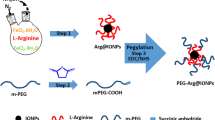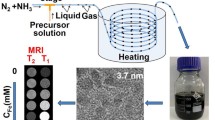Abstract
Layer-by-layer (LbL) assembled polyelectrolyte capsules have been widely studied as promising delivery systems due to their well-controlled architectures. Although their potential applications in vitro have been widely investigated, at present, it is still a challenging task to track their real-time delivery in vivo, where and how they would be located following their administration. In this work, the noninvasive magnetic resonance imaging (MRI) technique was applied to monitor the delivery of polyelectrolyte capsules in vivo, incorporating magnetite nanoparticles as imaging components. First, MRI scan was performed over 6 h after sample administration at the magnetic field of 3.0 T; magnetic capsules, both poly(allylamine hydrochloride)/poly(styrenesulfonate sodium salt)-based and poly-l-arginine hydrochloride/dextran sulfate (Parg/DS)-based, were detected mostly in the liver region, where the transverse relaxation time (T2) was shortened and hypointense images were visualized, demonstrating a contrast-enhanced MRI effect between liver and adjacent tissue. A continuous MRI scan found that the contrast-enhanced MRI effect can last up to 30 h; in the mean time, the Parg/DS-based capsules with smaller diameter were found to have a pronounced clearance effect, which resulted in a weakened MRI effect in the liver. No obvious toxicity was found in animal studies, and all mice survived after MRI scans. Histology study provided evidences to support the MRI results, and also revealed the destination of these magnetic capsules over 30 h after administration.







Similar content being viewed by others
References
Stuart, M. A. C., Huck, W. T. S., Genzer, J., Müller, M., Ober, C., Stamm, M., et al. (2010). Emerging applications of stimuli-responsive polymer materials. Nature Materials, 9, 101–113.
Delcea, M., Möhwald, H., Skirtach, A. G. (2011). Stimuli-responsive LbL capsules and nanoshells for drug delivery. Advanced Drug Delivery Reviews, 63, 730–747.
del Mercato, L., Rivera-Gil, P., Abbasi, A. Z., Ochs, M., Ganas, C., Zins, I., et al. (2010). LbL multilayer capsules: recent progress and future outlook for their use in life sciences. Nanoscale, 2, 458–467.
Klitzing, R. (2006). Internal structure of polyelectrolyte multilayer assemblies. Physical Chemistry Chemical Physics, 8, 5012–5033.
Skirtach, A. G., Yashchenok, A. M., Möhwald, H. (2011). Encapsulation, release and applications of LbL polyelectrolyte multilayer capsules. Chemical Communication, 47, 12736–12746.
Ariga, K., Lvov, Y. M., Kawakami, K., Ji, Q., Hill, J. P. (2011). Layer-by-layer self-assembled shells for drug delivery. Advanced Drug Delivery Reviews, 14, 762–771.
De Koker, S., Hoogenboom, R., De Geest, B. G. (2012). Polymeric multilayer capsules for drug delivery. Chemical Society Reviews, 41, 2867–2884.
De Koker, S., De Cock, L. J., Rivera-Gil, P., Parak, W. J., Auzély Velty, R., Vervaet, C., et al. (2011). Polymeric multilayer capsules delivering biotherapeutics. Advanced Drug Delivery Reviews, 63, 748–761.
De Geest, B. G., De Koker, S., Sukhorukov, G. B., Kreft, O., Parak, W. J., Skirtach, A. G., et al. (2009). Polyelectrolyte microcapsules for biomedical applications. Soft Matter, 5, 82–291.
Brown, M. A., & Semelka, R. C. (2011). MRI: basic principles and applications. Portland: Wiley.
Modo, M. M., & Bulte, J. W. (2007). Molecular and cellular MR imaging. Boca Raton: CRC.
Sheparovych, R., Sahoo, Y., Motornov, M., Wang, S., Luo, H., Prasad, P. N., et al. (2006). Polyelectrolyte stabilized nanowires from Fe3O4 nanoparticles via magnetic field induced self-assembly. Chemistry of Materials, 18, 591–593.
Semelka, R. C., & Helmberger, T. K. (2001). Contrast agents for MR imaging of the liver. Radiology, 218, 27–38.
Moffat, B. A., Reddy, G. R., McConville, P., Hall, D. E., Chenevert, T. L., Kopelman, R. R., et al. (2003). A novel polyacrylamide magnetic nanoparticle contrast agent for molecular imaging using MRI. Molecular Imaging, 2, 324–332.
Na, H. B., Song, I. C., Hyeon, T. (2009). Inorganic nanoparticles for MRI contrast agents. Advanced Materials, 21, 2133–2148.
Andrews, N. C. (1999). Disorders of iron metabolism. New England Journal of Medicine, 341, 1986–1995.
Hentze, M. W., Muckenthaler, M. U., Andrews, N. C. (2004). Balancing acts: molecular control of mammalian iron metabolism. Cell, 117, 285–297.
Nune, S. K., Gunda, P., Thallapally, P. K., Lin, Y. Y., Forrest, M. L., Berkland, C. J. (2009). Nanoparticles for biomedical imaging. Expert Opinion on Drug Delivery, 6, 1175–1194.
De Cock, L. J., De Koker, S., De Geest, B. G., Grooten, J., Vervaet, C., Remon, J. P., et al. (2010). Polymeric multilayer capsules in drug delivery. Angewandte Chemie International Edition, 49, 6954–6973.
Sukhorukov, G. B., Volodkin, D. V., Günther, A. M., Petrov, A. I., Shenoy, D. B., Möhwald, H. (2004). Porous calcium carbonate microparticles as templates for encapsulation of bioactive compounds. Journal of Materials Chemistry, 14, 2073–2081.
Gorin, D. A., Portnov, S. A., Inozemtseva, O. A., Luklinska, Z., Yashchenok, A. M., Pavlov, A. M., et al. (2008). Magnetic/gold nanoparticle functionalized biocompatible microcapsules with sensitivity to laser irradiation. Physical Chemistry Chemical Physics, 10, 6899–6905.
Köhler, K., & Sukhorukov, G. B. (2007). Heat treatment of polyelectrolyte multilayer capsules: a versatile method for encapsulation. Advanced Functional Materials, 17, 2053–2061.
Pavlov, A.M. (2012). Multilayer microcapsules for delivery, control and triggered release of bioactive compounds. (Unpublished dissertation). Queen Mary University of London, London
Berret, J. F., Schonbeck, N., Gazeau, F., El Kharrat, D., Sandre, O., Vacher, A., et al. (2006). Controlled clustering of superparamagnetic nanoparticles using block copolymers: design of new contrast agents for magnetic resonance imaging. Journal of the American Chemical Society, 128, 1755–1761.
Zhu, Y., Shi, J., Shen, W., Dong, X., Feng, J., Ruan, M., et al. (2005). Stimuli-responsive controlled drug release from a hollow mesoporous silica sphere/polyelectrolyte multilayer core–shell structure. Angewandte Chemie, 117, 5213–5217.
Déjugnat, C., & Sukhorukov, G. B. (2004). pH-responsive properties of hollow polyelectrolyte microcapsules templated on various cores. Langmuir, 20, 7265–7269.
Städler, B., Price, A. D., Zelikin, A. N. (2011). A critical look at multilayered polymer capsules in biomedicine: drug carriers, artificial organelles, and cell mimics. Advanced Functional Materials, 21, 14–28.
De Geest, B. G., Vandenbroucke, R. E., Guenther, A. M., Sukhorukov, G. B., Hennink, W. E., Sanders, N. N., et al. (2006). Intracellularly degradable polyelectrolyte microcapsules. Advanced Materials, 18, 1005–1009.
De Koker, S., De Geest, B. G., Singh, S. K., De Rycke, R., Naessens, T., Van Kooyk, Y., et al. (2009). Polyelectrolyte microcapsules as antigen delivery vehicles to dendritic cells: uptake, processing, and cross-presentation of encapsulated antigens. Angewandte Chemie, 121, 8637–8641.
Moghimi, S. M., Hunter, A. C., Murray, J. C. (2001). Long-circulating and target-specific nanoparticles: theory to practice. Pharmacological Reviews, 53, 283–318.
Edwards, D. A., Hanes, J., Caponetti, G., Hrkach, J., Ben-Jebria, A., Eskew, M. L., et al. (1997). Large porous particles for pulmonary drug delivery. Science, 276, 1868–1872.
Köhler, K., Shchukin, D. G., Möhwald, H., Sukhorukov, G. B. (2005). Thermal behavior of polyelectrolyte multilayer microcapsules. 1. The effect of odd and even layer number. The Journal of Physical Chemistry. B, 109, 18250–18259.
Leporatti, S., Gao, C., Voigt, A., Donath, E., Möhwald, H. (2001). Shrinking of ultrathin polyelectrolyte multilayer capsules upon annealing: a confocal laser scanning microscopy and scanning force microscopy study. The European Physical Journal E, 5, 13–20.
Zhang, R., Köhler, K., Kreft, O., Skirtach, A., Möhwald, H., Sukhorukov, G. B. (2010). Salt-induced fusion of microcapsules of polyelectrolytes. Soft Matter, 6, 4742–4747.
Ai, H. (2011). Layer-by-layer capsules for magnetic resonance imaging and drug delivery. Advanced Drug Delivery Reviews, 63, 772–788.
Wang, Y. X., Hussain, S. M., Krestin, G. P. (2001). Superparamagnetic iron oxide contrast agents: physicochemical characteristics and applications in MR imaging. European Radiology, 11, 2319–2331.
Corot, C., Robert, P., Idée, J.-M., Port, M. (2006). Recent advances in iron oxide nanocrystal technology for medical imaging. Advanced Drug Delivery Reviews, 58, 1471–1504.
Lu, J., Ma, S., Sun, J., Xia, C., Liu, C., Wang, Z., et al. (2009). Manganese ferrite nanoparticle micellar nanocomposites as MRI contrast agent for liver imaging. Biomaterials, 30, 2919–2928.
Mikhaylov, G., Mikac, U., Magaeva, A. A., Itin, V. I., Naiden, E. P., Psakhye, I., et al. (2011). Ferri-liposomes as an MRI-visible drug-delivery system for targeting tumours and their microenvironment. Nature Nanotechnology, 6, 594–602.
Liu, G., Wang, Z., Lu, J., Xia, C., Gao, F., Gong, Q., et al. (2011). Low molecular weight alkyl-polycation wrapped magnetite nanoparticle clusters as MRI probes for stem cell labeling and in vivo imaging. Biomaterials, 32, 528–537.
Xie, J., Liu, G., Eden, H. S., Ai, H., Chen, X. (2011). Surface-engineered magnetic nanoparticle platforms for cancer imaging and therapy. Accounts of Chemical Research, 44, 883–892.
Knoblaugh, S., Randolph-Habeckers, J., Rath, S. (2012). Necropsy and histology. In P. Treuting & S. M. Dintzis (Eds.), Comparative anatomy and histology: a mouse and human atlas (1st ed., p. 23). Oxford: Elsevier.
Torchilin, V. P. (2006). Multifunctional nanocarriers. Advanced Drug Delivery Reviews, 58, 1532–1555.
Ai, H., Pink, J. J., Shuai, X., Boothman, D. A., Gao, J. (2005). Interactions between self-assembled polyelectrolyte shells and tumor cells. Journal of Biomedical Materials Research, Part A, 73, 303–312.
Brigger, I., Dubernet, C., Couvreur, P. (2002). Nanoparticles in cancer therapy and diagnosis. Advanced Drug Delivery Reviews, 54, 631–651.
Heuberger, R., Sukhorukov, G. B., Vörös, J., Textor, M., Möhwald, H. (2005). Biofunctional polyelectrolyte multilayers and microcapsules: control of non-specific and bio-specific protein adsorption. Advanced Functional Materials, 15, 357–366.
Acknowledgments
The authors thank the Radiology Department of West China Hospital (Sichuan University, China) for the support on the MRI measurement. The authors also acknowledge the National Natural Science Foundation of China (NSFC 51173117) and National Key Basic Research Program of China (2013CB933903) for the financial support. This research was supported by an EPSRC “Global Engagement” grant to establish research links between Queen Mary University of London, and Sichuan University.
Author information
Authors and Affiliations
Corresponding authors
Additional information
The authors Q. Yi and D. Li contributed equally to this work.
Rights and permissions
About this article
Cite this article
Yi, Q., Li, D., Lin, B. et al. Magnetic Resonance Imaging for Monitoring of Magnetic Polyelectrolyte Capsule In Vivo Delivery. BioNanoSci. 4, 59–70 (2014). https://doi.org/10.1007/s12668-013-0117-2
Published:
Issue Date:
DOI: https://doi.org/10.1007/s12668-013-0117-2




